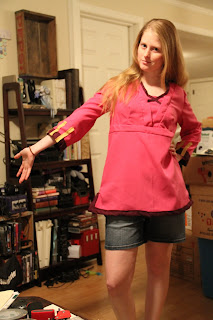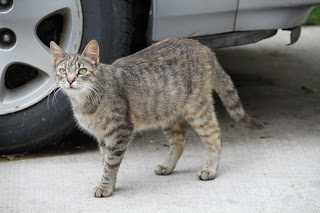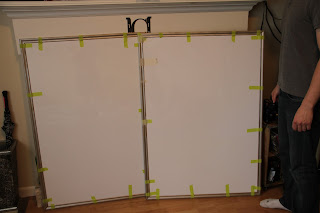When we first moved in, we considered buying barrister bookcases (still want one someday), but they are extremely expensive. For good reason, but still ... here's an example of a real wood barrister:
Almost $1000, yipes! We did some shopping around and prices vary some, but it seemed like most of the single boxes were at least $150-$200 each (and then you just get as many as you want to stack).
So then we considered an MDF barrister like this one:
Much better price ... but we hate MDF. Did you know that for a 3' wide bookcase, MDF can only hold about 9 pounds before it starts to sag? That just wasn't going to cut it for the amount of books we have.
Then we considered building our own barristers, using this really handy guide:
There is a really helpful PDF on the second page of the website. If you are into woodworking and a little better than beginner, you could do this project. We looked at costs and thought we might be able to make this bookcase for around $400 (total for a 4-shelf case). We didn't factor glass costs into that, though. Still, it would have been a much better deal than any real wood versions we'd seen so far. BUT - I thought it would be a little too difficult for me and time consuming. It was the middle of the school year and we needed something quick so we could unload at least a few of our boxes of books. I wanted something simple.
So, I designed a much simpler bookcase and now we've made four of them.
INSTRUCTIONS FOR BUILDING A SIMPLE BOOKCASE
(P.S.: a Kreg jig is essential to these instructions)
*Note that we used cheap boards from Lowes. I think the bookcase still looks nice, but with more costly/better boards, it could look even more professional. Also, if you don't hate sanding as much as me and you really sand down the tops of the shelves or put second coats of polyurethane, that could make it look more sleek.
**These materials and instructions are for a 3' by 6' 4" bookcase with 4-6 shelves. It should be easy to adjust the dimensions to fit your needs; just factor in whether you need more or less wood.
Materials:
Three 1x12x6 Whitewood Boards
- Use: sides, top, and bottom of bookcase
- Cost: $9.98 per board ($29.94)
Three 1x10x6 Whitewood Boards
- Use: 3-4 adjustable shelves and 1 stationary shelf
- Cost: $6.92 per board ($20.76)
Three 1x2x6 Whitewood Boards
- Use: shelf front trim/enforcers for 4-5 shelves
- Cost: $1.48 per board ($4.44)
1 Sheet 1/2 inch or 15/32 4' x 8' sheeting or some other plywood
- Use: backing for bookcase
- Cost: $18.67 for one sheet
* Note: we bought 3/4 inch sheets the first two times. That made the bookcases immensely more heavy than when we switched to 1/2 inch. Also, this is one place where you could spend more for it to look better, maybe with panels or something? The sheeting is not the prettiest, but it is also mostly covered by books in our bookcase.
Optional: 4 pre-made legs
- Use: legs so your bookcase doesn't just sit on the floor
- Cost: the "Portsmouth Bun Foot" I bought costs $6.98 per foot ($27.92 total) and is almost the most expensive part of the bookcase. It would be way less costly to build legs ourselves ... but I like how they look and don't want to go to that extra work. Since the rest of the bookcase is pretty inexpensive, I feel okay splurging on those legs. It is kind of ridiculous that they cost THAT much.
32oz of Stain (we got Red Mahogany Minwax)
- Use: for color and to hide imperfections. Dark stain is good if you are using plywood for backing since it hides a lot of the not-pretty-parts of the plywood.
- Cost: $7.77
32oz Polyurethane (we got Minwax Semi-Gloss)
- Use: to seal the bookcase
- Cost: $10.77
A KREG JIG and screws for it! This design uses primarily Kreg screws plus about 20 regular wood screws for attaching the backing.
Adjustable Shelf Supports (4 per adjustable shelf)
Total Cost:
Wood: $73.81
Stain/Sealer: $18.54
Legs: (optional) $27.92
Minimal cost for screws and shelf supports
Grand Total: $92.35 - $120.27
All right, now to the instructions! I just wanted to prove to you that it was worth it with the cost analysis.
Steps Overview:
1. Cut and Assemble the Bookcase Frame
2. Cut and Attach the Backing/Legs
3. Cut and Assemble the Shelves
4. Drill the Adjustable Shelf Holes
5. Stain and Seal
Steps 1-4 can easily be done in one day if you have all your materials and you start early. You can even stain at the end of the day if you get that far. If your drying conditions are ideal, putting on the polyurethane on day 2 makes this a quick weekend project. After that, you just need to wait a couple of days for the polyurethane to completely dry and out-gas before bringing the bookcase into your home to fill with books!
STEP 1: Cut and Assemble the Bookcase Frame
Sides: Cut two of the 1x12x6 boards to 71" for the sides of the bookcase. (Ok, I don't really know why I did that in the first place ... I think to shorten it since I'd be adding legs. But really, if the ends are not damaged at all, you could just leave it at 6'. Or, if you want the bookcase to be no higher than 6', then you could cut down the sides so that once you add the legs, the bookcase is 6' tall from the ground.
Top and Bottom: Cut the remaining 1x12x6 board into two 35" pieces. Make sure to look over the boards thoroughly to decide which sides will be the inside and outside faces. Remember that the top and bottom outside faces won't really show.

Use the Kreg jig to attach the top and bottom INSIDE the sides. I use three Kreg holes on both ends of one side of the top and bottom pieces. The ones on the bottom piece end up being covered by books and the ones on the top hardly show. You could also fill them with Kreg hole fillers. I assemble the bookcase with the back side up so that when I go to attach the backing, it is already in the right position.
STEP 2: Cut and Attach the Backing and Legs
Even though you know the measurements of the outside edges, MEASURE AGAIN ANYWAY. Sometimes the cheaper boards are a little warped in the middle along the side edges, so measure corner to corner mainly.
Cut the backing board to fit. For my bookcases, my measurements are always 71" for the sides and 36.5" across the top/bottom (my 35" cut plus 1.5" for the thickness of the side boards). I use a chalk line to mark the plywood then cut it with a jigsaw. That part is not fun since the piece is so big and you don't want wobbly edges since it will show when you are looking at the back edge of the bookcase.
Lay the backing over the frame. Align the corners and attach one of them first using regular wood screws. After one or two corners are attached, you may have to push straight any bowed sides to align them. Once, when we had a side piece bow inward, we had to cut a piece of wood and lay it inside the bookcase before putting the backing on to push out the side so it would align to the backing.
We usually use 7 screws along each side (counting the corners) and 5 along the top and bottom (counting the corners), or about 20 screws total.
To attach the pre-made legs I bought, which have a screw already attached to the top, I measure in 2" square on the bottom piece at each corner. Drill a hole to fit the screw (I think they are 1/4" thick). Be careful not to drill all the way through the bottom board! Then screw in the pre-made leg. Now you can stand up your bookcase.
STEP 3: Cut and Assemble the Shelves
Cut as many shelves as you would like from the 1x10x6 boards. You could just buy two of these boards if you want just the bottom shelf and 4 other shelves. To get 6 or 7 shelves, you'll need three of these boards.
Basically you need to cut the shelves to fit inside the case frame, so for my bookcase they need to be 35", the same length as the top and bottom (since those fit inside the sides). HOWEVER, depending on what kind of shelf supports you buy, you will probably need to cut the shelves slightly shorter, except for the stationary shelf.
For the stationary shelf, cut the shelf the same length as the top and bottom. For each shelf, you will cut a piece of the 1x2x6 board to the same length as the shelf and attach it with Kreg screws. This adds support to the shelf so it won't sag, and it also looks nice in the bookcase. For the stationary shelf, you'll also make Kreg holes on the short sides of the shelf to attach it to the inside of the bookcase for support.
Decide where you want the stationary shelf to go, mark it, and make sure it will be level. I put mine around 42" from the inside bottom of the case frame. Attach it to the sides with Kreg screws. If the back of the bookcase isn't perfectly flush with the back of the stationary shelf, you may want to use regular wood screws to attach it from the back as well. Measuring that is a little tricky, but I have done it on all the bookcases and it helped. I suppose you could also use the Kreg jig for that too, if you think ahead about that and remember to adjust your Kreg jig for the thinner plywood backing.
For adjustable shelves, cut the shelves slightly less than the inside width of the bookcase. My shelf pegs look like this:
So I have to account for a decent amount of space for the shelf to slip over the edge of the peg (like, maybe 1/8 to 3/16 of an inch total). I always have trouble cutting the shelves slightly too long and it is really frustrating to have to go cut them again later. Make sure to test the shelves before staining!
Add front trim to the adjustable shelves just like the stationary one.
STEP 4: Drill the Adjustable Shelf Holes
I have made a measuring "jig" for these holes but somehow they still always come out slightly off, or the drill slips a little and the hole isn't exactly level ... they are a pain. But, so far the worst ones were fixable by putting padding on my shelf pegs to level the shelf. Not ideal, but an okay fix. I drill holes every two inches starting 8 inches from the bottom of the case and 8 inches from the top of the adjustable shelf. I drill the holes at about 2 inches and 8 inches from the back of the case. My holes are 1/4" to match the pegs, and I use a peg to test the depth of each hole after I've cut them all, deepening any that need it. Again, be careful not to cut all the way through the side!
STEP 5: Stain and Seal
Whew, by now, you are probably tired of this project and ready to be done if you are anything like me. I just want it finished so I can put my books on it!
Stain the bookcase. I use a rag to wipe on the stain. I stain everything except the bottom since the bookcase is upright and too heavy for me to want to lay it over just for that. The legs can be tricky if you buy pre-made fancy ones like mine that have grooves. Also, the backing sucks up a lot of stain, but 32oz is always more than enough. I think you could maybe do two bookcases with that much, actually.
The trickiest part here is staining the adjustable shelves. I use these little pyramid-shaped stands to sit the shelves on. I stain the backside, wait an hour or so, then flip it and stain the top. Since the pyramids only touch at a few points, it doesn't mess up the stain too much even if it is still damp.
Wait at least overnight until the stain is dry, then brush on your preferred polyurethane. Again, you'll have to do the adjustable shelves in two stages. Be careful not to overdo it on the polyurethane here .... when I did some of my shelves, the poly made my stain run a bit and make "drips" on the front edge of the shelves.
Now, all you have to do is wait for the bookcase to dry and out-gas.
Here are all four of our bookcases in action:









































